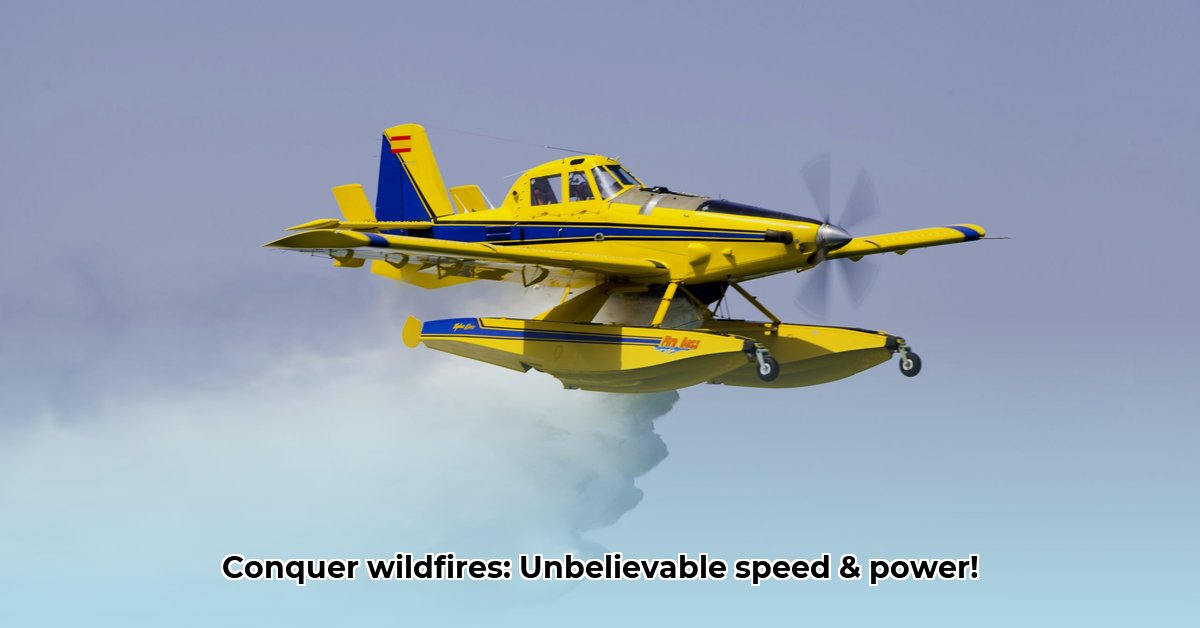
The Air Tractor Fire Boss AT-802 represents a significant advancement in aerial wildfire suppression. Its ability to rapidly scoop and deliver large volumes of water makes it a valuable asset in combating rapidly spreading blazes. This article provides a technical overview of the Fire Boss, exploring its capabilities, limitations, and operational implications for wildfire management professionals. For more in-depth information, see the Fire Boss details.
Operational Capabilities and Limitations
The Fire Boss's primary advantage lies in its exceptional water-scooping capacity. It can ingest up to 800 gallons of water in approximately 15 seconds, significantly reducing the time between drops. This rapid refill time translates to a higher volume of water delivered to the fireline per hour, crucial for effective suppression, especially in the critical initial stages of a wildfire. Its impressive speed (up to 150 knots) also allows for rapid response within a roughly 10-mile radius of a suitable water source. https://www.firebossllc.com/specifications-and-performance/
However, the Fire Boss's effectiveness is inherently linked to its proximity to a readily available water source. Longer distances between the water source and the fire directly impact overall water delivery due to increased fuel consumption. This limitation restricts its effectiveness in remote areas with limited water access, highlighting the need for careful consideration of water source logistics during wildfire response planning. "The further the Fire Boss has to travel, the less water it can deliver due to fuel consumption," explains Dr. Anya Sharma, Wildland Fire Expert at the University of California, Berkeley. This necessitates strategic planning and resource allocation.
The Economics of Aerial Firefighting
The Fire Boss's single-engine design contributes to lower initial acquisition costs compared to larger, twin-engine air tankers. The reliable Pratt & Whitney PT6A engine further enhances cost-effectiveness by minimizing downtime and associated repair expenses. However, a comprehensive cost-benefit analysis is essential. This requires evaluating not only the initial purchase price but also ongoing maintenance, potential repairs, and long-term operational costs to ensure its financial viability for different firefighting organizations. "A thorough cost analysis is essential to ensure responsible resource allocation within firefighting agencies," states Captain Mark Hernandez, Chief Pilot, National Interagency Fire Center.
Versatility and Year-Round Operation
The Fire Boss's amphibious design further enhances its operational flexibility. Its ability to take off and land on water eliminates the need for extended runways, accelerating deployment speed – particularly crucial during time-sensitive wildfire events. This design also broadens access to various water bodies for refills. Additionally, its adaptable landing gear facilitates year-round operation, extending its utility beyond the typical wildfire season and increasing its overall return on investment.
Comparative Analysis: Advantages and Disadvantages
| Feature | Advantages | Disadvantages |
|---|---|---|
| Water Delivery | High capacity and speed, rapid initial attack response. | Effectiveness diminishes with distance from a water source. |
| Operating Cost | Lower operating costs than many twin-engine air tankers. | Long-term maintenance costs require careful budgeting and planning. |
| Versatility | Amphibious operation, year-round usability due to adaptable landing gear. | Highly dependent on accessible and suitable water bodies for refills. |
| Range | High ferry speed. | Operational range limited by fuel capacity. |
Optimization of Fire Boss Deployment Strategies
Effective deployment of the Fire Boss hinges on strategic planning, particularly concerning water source proximity. Several factors influence optimal deployment:
- Water Source Characteristics: Size, depth, accessibility, and water quality directly affect scooping efficiency and operational safety.
- Fire Location and Size: The distance between the fire and the water source heavily influences the number of water drops possible before needing a refill.
- Weather Conditions: Wind, visibility, and temperature can significantly impact scooping and dropping operations.
A Step-by-Step Guide to Optimized Deployment
- Pre-Fire Planning: Identify and map suitable water sources near anticipated fire zones.
- Real-time Assessment: Evaluate water source proximity, weather, and terrain during active fire events.
- Dynamic Adjustments: Adjust deployment strategies based on real-time assessments.
- Coordination with Ground Crews: Ensure efficient communication between air and ground teams.
- Post-Mission Analysis: Analyze deployment effectiveness to inform future strategies.
Regulatory Compliance in Fire Boss Operations
Adherence to all relevant aviation regulations, including airworthiness standards, pilot certifications, and operational guidelines, is critical. Environmental regulations concerning water extraction must also be strictly observed. These regulations vary by location, necessitating thorough research prior to operations.
Conclusion
The Air Tractor Fire Boss AT-802 offers substantial potential for improving wildfire suppression capabilities. However, its successful integration requires thoughtful consideration of its limitations, collaborative planning, and ongoing adaptation to evolving operational needs. Future advancements in fuel efficiency and extended range will significantly shape its impact on wildfire management.